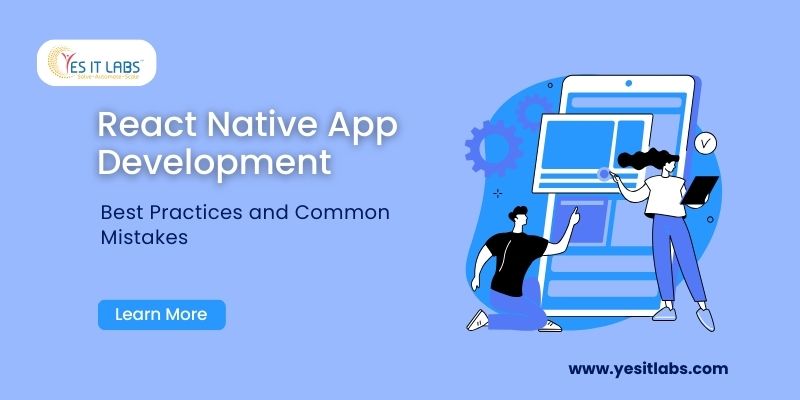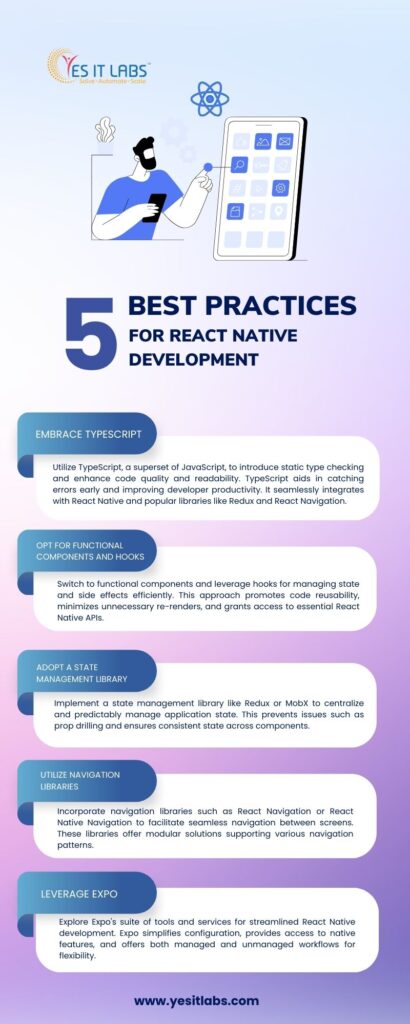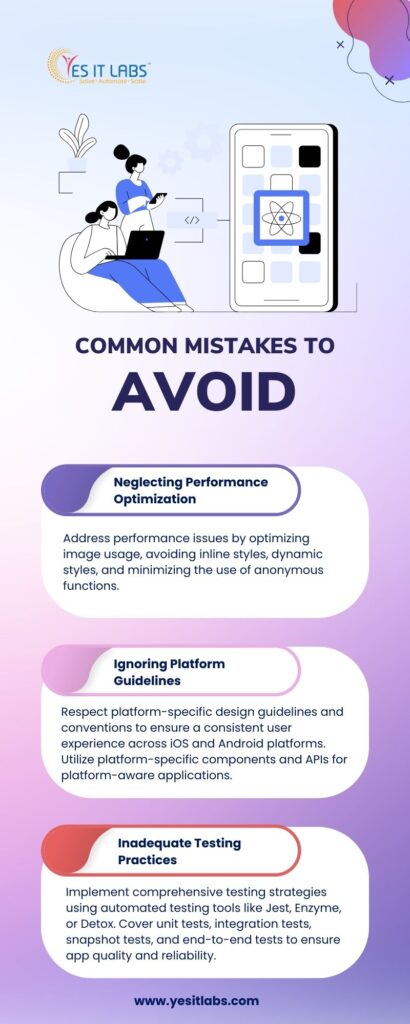
 By Admin
By Admin React Native App Development: Best Practices and Common Mistakes
React Native is a widely embraced framework for developing cross-platform mobile applications. It allows information technology (IT) consulting companies to reuse code across different platforms, such as iOS and Android, and create native-like user interfaces with minimal effort. However, developing a React Native app is not without its challenges and pitfalls. In this article, we will discuss some of the best practices and common mistakes that developers should follow and avoid when working with React Native.
- Best Practices
- Common Mistakes
- FAQs.
- Q: What is React Native?
- Q: What are the benefits of using React Native?
- Q: What are the challenges and pitfalls of using React Native?
- Q: How can I optimize the performance of my React Native app?
- Q: How can I follow the platform guidelines of iOS and Android?
- Q: How can I test my React Native app properly?
Best Practices
 Use TypeScript
Use TypeScript
TypeScript extends JavaScript by incorporating static type checking and additional functionalities into the language. It helps developers catch errors and bugs early, improve code quality and readability, and enhance developer productivity and tooling. React Native supports TypeScript out of the box, and popular libraries and frameworks like Redux, React Navigation, and Expo can easily integrate with it.
Use functional components and hooks
Functional components are simpler and more concise than class-based components, and they allow developers to use hooks, which are a new way of managing state and side effects in React. Hooks make it easier to share and reuse logic across components, avoid unnecessary re-rendering, and access the React Native API, such as useEffect, useLayoutEffect, useCallback, useMemo, and useRef.
Use a state management library
State management is one of the most complex and important aspects of any React Native app. It involves keeping track of the data and UI state of the app, and ensuring that they are consistent and synchronized. A state management library, such as Redux, MobX, or Recoil, can help developers manage state in a centralized and predictable way, and avoid prop drilling, unnecessary re-rendering, and state inconsistency.
Use a navigation library
Navigation is another essential feature of any React Native app. It involves moving between different screens and components, and providing feedback and transitions to the user. A navigation library, such as React Navigation, React Native Navigation, or React Router Native, can help developers implement navigation in a declarative and modular way, and support various navigation patterns, such as stack, tab, drawer, and modal.
Use Expo
Expo is a set of tools and services that simplify and accelerate the development and deployment of React Native apps. It provides a managed workflow that handles the configuration and setup of the app, and allows developers to access native features and APIs, such as camera, location, notifications, and sensors, without writing any native code. Expo also provides an unmanaged workflow that gives developers more control and flexibility over the native code, and supports custom native modules and libraries.
Common Mistakes
 Not optimizing performance.
Not optimizing performance.
Performance is a crucial factor for any React Native app development company, as it affects the user experience and satisfaction. However, many developers neglect or overlook performance optimization, and end up with slow and laggy apps. Some of the common performance issues and solutions are:
- Using too many images or large images: Images are one of the main sources of memory and bandwidth consumption in React Native apps. Developers should use images sparingly, and optimize them for size and quality. They should also use the Image component from React Native, which supports caching, resizing, and lazy loading of images.
- Using inline styles or dynamic styles: Styles are another source of performance overhead in React Native apps. Developers should avoid using inline styles or dynamic styles, as they cause unnecessary re-rendering and computation of styles. They should use StyleSheet from React Native, which creates optimized and static stylesheets, and supports memoization and inheritance of styles.
- Using anonymous functions or arrow functions: Functions are also a source of performance degradation in React Native apps. Developers should avoid using anonymous functions or arrow functions, especially in props, as they create new instances of functions on every render, and cause unnecessary re-rendering and memory allocation. They should use named functions or useCallback hook, which create stable and reusable functions, and prevent re-rendering and memory leaks.
Not following the platform guidelines.
React Native allows developers to create cross-platform apps that run on both iOS and Android. However, this does not mean that the apps should look and behave exactly the same on both platforms. Each platform has its own design and user interface guidelines, such as Material Design for Android and Human Interface Guidelines for iOS, and users expect the apps to follow them. Developers should respect the platform differences and conventions, and use platform-specific components and APIs, such as Platform, Platform.OS, Platform.select, and PlatformColor, to create platform-aware and platform-adaptive apps.
Not testing the app properly.
Testing is an essential part of any React Native app development process, as it ensures the quality and reliability of the app. However, many developers skip or ignore testing, and rely on manual testing or debugging tools, such as React Native Debugger or Flipper, to find and fix errors and bugs. This is not enough, as manual testing and debugging are time-consuming, error-prone, and incomplete. Developers should use automated testing tools and frameworks, such as Jest, Enzyme, React Testing Library, or Detox, to write and run unit tests, integration tests, snapshot tests, and end-to-end tests, and cover all the aspects and scenarios of the app.
FAQs.
Q: What is React Native?
React Native is a framework for building cross-platform mobile applications using JavaScript and React.
Q: What are the benefits of using React Native?
A: React Native allows developers to reuse code across different platforms, such as iOS and Android, and create native-like user interfaces with minimal effort.
Q: What are the challenges and pitfalls of using React Native?
A: React Native also has some drawbacks and limitations, such as performance issues, platform differences, and native dependencies.
Q: How can I optimize the performance of my React Native app?
A: Some of the ways to improve the performance of your React Native App Development are using TypeScript, functional components and hooks, state management and navigation libraries, and Expo. You should also avoid using too many images or large images, inline styles or dynamic styles, and anonymous functions or arrow functions.
Q: How can I follow the platform guidelines of iOS and Android?
A: You should respect the platform differences and conventions, and use platform-specific components and APIs, such as Platform, Platform.OS, Platform.select, and PlatformColor, to create platform-aware and platform-adaptive apps.
Q: How can I test my React Native app properly?
A: You should use automated testing tools and frameworks, such as Jest, Enzyme, React Testing Library, or Detox, to write and run unit tests, integration tests, snapshot tests, and end-to-end tests, and cover all the aspects and scenarios of the app.
Tags: Best Practices for React Native App Development, business it consulting services, Common Mistakes in React Native App Development, Information Technology (IT) consulting companies, IT consulting company in USA, it consulting services for business, react native app development company, React Native app development company in USA, React Native development companyLatest Resources
Transforming Your Shopify Store with Node.js App Development
April 30, 2024
Xamarin Trailblazers: Pioneering the Future of Mobile Apps
April 29, 2024






















 Services
Services


